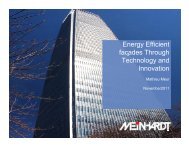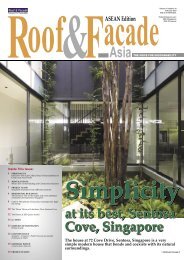ICA_Feb 07.pdf - Roof & Facade
ICA_Feb 07.pdf - Roof & Facade
ICA_Feb 07.pdf - Roof & Facade
You also want an ePaper? Increase the reach of your titles
YUMPU automatically turns print PDFs into web optimized ePapers that Google loves.
Energy<br />
different institutional supports in comparison to the<br />
Biomass application. The GOM, through the MECM<br />
is committed to implement the MBIPV project with<br />
the support and assistance from the GEF in order<br />
to realize this long-term solar energy potential in<br />
Malaysia.<br />
A PV system, either a stand-alone or a gridconnected,<br />
is classified as a BIPV system whenever<br />
the PV is aesthetically integrated into the building<br />
architecture and envelope. Most of the BIPV<br />
applications today are grid-connected systems that<br />
are applied in urban areas. The stand-alone PV is a<br />
system installation that requires a battery to operate<br />
and is mostly applied in remote areas. A standalone<br />
PV only produces electricity for the intended<br />
use (e.g., household electricity consumption,<br />
telecommunication systems and navigational<br />
systems).<br />
A building integrated PV (BIPV) system will not<br />
only produce electricity, but will also be an integral<br />
part of the building envelope, with a specific<br />
function (e.g. window shading device, roof,<br />
decorative building façade). Hence, the substituted<br />
building materials will partially offset the BIPV<br />
technology cost. Also, land space for the technology<br />
application will not be an issue. BIPV systems, in<br />
almost all cases, will also improve the aesthetic<br />
exterior appearance of the building.<br />
The most important benefits of BIPV, especially<br />
in urban areas, will be the opportunity to utilize<br />
PV technology without the need of land-use. As the Solar Panels on Residential Building<br />
cost of land is significant in urban areas, BIPV will<br />
allow the utilization of PV technology to generate electricity without incurring<br />
the additional cost of the land-use.<br />
BIPV is a different technology approach compared to a stand-alone PV<br />
application. It is well accepted among the PV industry that BIPV offers greater<br />
benefits in comparison to stand-alone PV application. A sustainable BIPV market<br />
means that the prospective users of the technology can afford and will continue<br />
to apply the technology. Such customers are available in the urban areas. Thus,<br />
urban BIPV application will provide greater chances of success in comparison to<br />
stand-alone PV, which are mainly applied in remote locations.<br />
The MBIPV project will catalyse the wider adoption of grid-connected BIPV<br />
applications. The project strategies focus on implementation of cost-reduction<br />
and capacity building activities, which include showcases of BIPV to demonstrate<br />
various possibilities and essential references in utilising BIPV technology. In<br />
parallel, information dissemination and promotion activities will be carried out.<br />
The various project components are designed specifically to achieve the longterm<br />
cost reduction of grid-connected BIPV applications in Malaysia. The<br />
activities are intended to build on the existing capacity already available in<br />
Malaysia. The combined effects of the MBIPV project activities are expected to<br />
‘jump-start’ BIPV applications and BIPV market in Malaysia.<br />
The goal of the project is to reduce the annual growth rate of GHG emissions<br />
from fossil fuel-fired power generators, via the widespread implementation of<br />
BIPV application to replace part of the current fossil fuel use, and via the cost<br />
reduction of the BIPV technology. The project purpose is to significantly improve<br />
the overall capacity of government and private sectors, to develop, design and<br />
utilise BIPV energy potential, as well as to develop local BIPV industry. It will<br />
address the GEF strategic priority on market aggregation, product innovation<br />
and capacity building specifically for<br />
BIPV technology. The proposed project<br />
is made up of four components that will<br />
address in an integrated manner the<br />
long-term cost reduction of BIPV<br />
technology, and the adoption of<br />
supportive regulatory frameworks for<br />
BIPV sustainability and replicability.<br />
Financial Modality and Cost<br />
Effectiveness<br />
Sustainability is an integral element of<br />
the MBIPV project, and it is ensured<br />
through the outputs of the project<br />
components. The National PV Council<br />
(NPVC), which will be industry driven,<br />
will continue to spearhead and sustain<br />
the activities after the project life. The<br />
Malaysia Energy Center (PTM), as the<br />
government’s think-tank on energy<br />
related issues, will become the advocate<br />
and catalyst for BIPV development<br />
within the national framework. The<br />
improved capacity of the local industry<br />
– together with the availability of<br />
standards, training modules and<br />
resource center – will ensure that the<br />
local players can continue to design and<br />
install BIPV systems. The developed<br />
BIPV policy and financing mechanisms<br />
(including an attractive buyback tariff)<br />
will ensure continuous and sustainable<br />
follow-up BIPV programs within the<br />
10th Malaysia Plan and subsequent five-<br />
year development plans of the country.<br />
During the PDF-B project activities, a large<br />
number of stakeholders have been consulted in<br />
the formulation of the project. Overall, more<br />
than 120 different stakeholders were involved<br />
during the LFA workshops, in addition to<br />
numerous stakeholders’ meetings and<br />
participation of more than 220 participants<br />
during the national BIPV seminar. These<br />
stakeholders include government agencies,<br />
financial institutions, power utilities, service<br />
providers, PV manufacturers, project<br />
developers, architects, professionals<br />
associations, NGOs and others. To continue with<br />
this broad consulting approach, the MBIPV<br />
project will draw upon the NPVC to induce<br />
participation and represent those stakeholders,<br />
as well as providing links to other national and<br />
international institutions.<br />
Excluding the PDF-B activities, the total<br />
estimated MBIPV project cost is US$ 24,959,160.<br />
From this, a total of US$ 20,259,740 (51% cash<br />
and 30% in-kind) will be used for baseline<br />
activities. The rest (US$ 4,699,420) are for the<br />
incremental activities that will be supported by<br />
the GEF. The Government of Malaysia and the<br />
private sector (national and international) will<br />
co-finance the baseline cost.<br />
The US$ 4,699,420 fund request from GEF<br />
will be utilised as follows: (a) US$ 2,551,000<br />
(54%) for personnel and mission costs to<br />
implement all project component activities; (b)<br />
US$ 764,210 (16%) for various capacity building and training activities; (c)<br />
US$ 1,200,000 (26%) for enhancement of the local market and purchase of the<br />
necessary BIPV equipment and hardware; (d) US$ 184,210 (4%) for subcontract<br />
and sub-consultancy costs to undertake various surveys and business<br />
development models. ❏<br />
PROJECT FACTS:<br />
Agency’s Project ID: 2754<br />
Country: Malaysia<br />
Project Title: Building Integrated Photovoltaic (BiPV) Technology Application<br />
Project<br />
GEF Agency: United Nations Development Programme (UNDP)<br />
Duration: Five Years<br />
GEF Focal Area: Climate Change<br />
GEF Operational Programme: OP-7; Reduction of Long-Term Costs of Low<br />
Greenhouse Gas-Emitting Energy Technologies<br />
GEF Strategic Priority: (S5) Global Market Aggregation and National Innovation<br />
for Emerging Technologies<br />
<strong>ICA</strong> Volume 1 Issue 1 2007 11
















